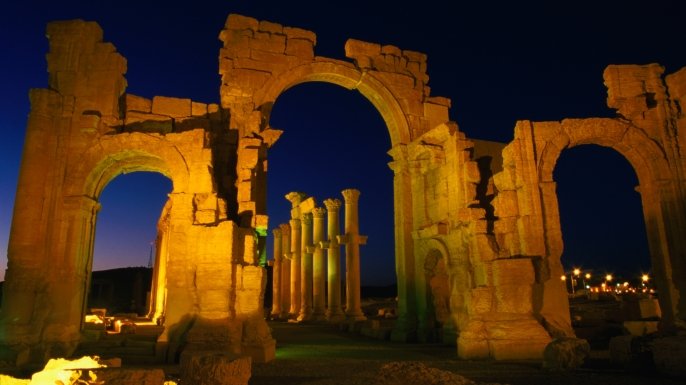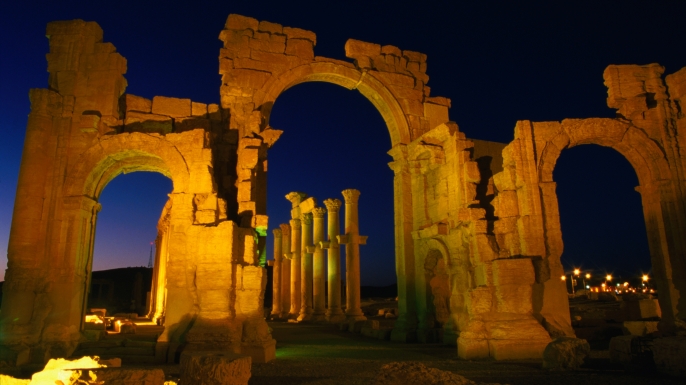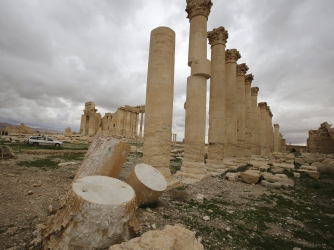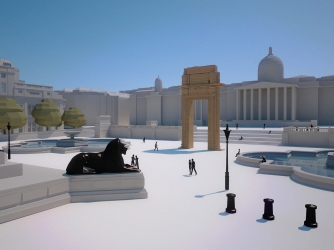

Measuring some 15 meters (nearly 50 feet) high, the entrance arch of Palmyra’s Temple of Bel was one of the few things left standing after the extremist group known as the Islamic State in Iraq and Syria (ISIS) sought to systematically destroy the city and its ancient monuments earlier this year. Now, as a symbol of defiance against the jihadists who seek to erase the pre-Islamic history of the Middle East, the Palmyra arch will be recreated using a giant 3D printer and erected in prominent locations in London and New York City. The replicas, symbolizing the enduring importance of our shared cultural heritage, will serve as the centerpiece of World Heritage Week next April.
Located some 130 miles northeast of Damascus, the Syrian city of Palmyra (meaning “city of palms”) has long been called the Pearl of the Desert. Before conflict tore through Syria in 2011, more than 150,000 tourists visited Palmyra each year, drawn by the ancient city’s rich cultural heritage. But after April 2015, when the extremist group known as ISIS took control of Palmyra, the international community watched in horror as the group targeted the ancient city’s most famous landmarks in its campaign to destroy the Middle East’s pre-Islamic monuments, tombs and statues.

Chief among these was the Temple of Bel, which has been called the most important temple in the entire Middle East, along with Lebanon’s Baalbek. Construction of the temple began in A.D. 32 and was completed in the 2nd century. Consecrated to the pagan god Bel, who was often depicted carrying a palm leaf, the temple served as the heart of religious life in the Syrian city for centuries. It was converted to a Christian church during the Byzantine Empire, and later became a mosque after Islam arrived in the region in the 7th century.
In August 2015, ISIS executed Khaled al-Asaad, an 82-year-old archaeologist who had tended the ancient ruins of Palmyra for some 40 years. According to Syria’s antiquities chief, Maamoun Abdulkarim, al-Asaad was beheaded and his body was hung in public. Later that month, a week after ISIS detonated explosives in Palmyra’s ancient Baal Shamin temple, the United Nations released satellite images confirming that the organization had also reduced the Temple of Bel to rubble. Only the perimeter wall and the entrance arch, badly damaged, were left standing. The United Nations Educational, Scientific and Cultural Organization (UNESCO), which had named Palmyra a World Heritage Site, called the temple’s destruction a war crime aimed at an invaluable symbol of Syria’s diverse cultural heritage.
The Institute for Digital Archaeology (IDA), a joint venture between Harvard University, the University of Oxford and Dubai’s Museum of the Future, is taking an innovative approach in defying such acts of extremist violence. Earlier this year, the organization, which promotes the use of digital imaging and 3D printing in archaeology and conservation, collaborated with UNESCO in the distribution of 3D cameras to volunteer photographers. These volunteers were asked to snap photos of threatened cultural objects in conflict-ridden areas in the Middle East and northern Africa. The images will be uploaded to a database intended for research, educational programs and—eventually—3D replication.

Though the Temple of Bel was destroyed before images of it could be captured and included in the database, researchers have managed to create 3D approximations of the structure using thousands of regular two-dimensional photographs. The full-size replica arches planned for New York and London will be made off-site using a combination of 3D printing computer-controlled machining techniques; the materials will be stone powder and a lightweight composite. The structures will then be assembled in Trafalgar Square and Times Square for display during World Heritage Week in April 2016.
As Alexy Karenowska, a physicist at Oxford and IDA’s director of technology, explained to the Guardian: “The idea is to underline that cultural heritage is something that’s shared between people. It’s about people’s roots and it’s important to recognize also that this is something that as humans we do all understand on some deep level.”
But according to IDA executive director Roger Michel, the project is about more than just appreciating a shared cultural heritage. “It is really a political statement, a call to action, to draw attention to what is happening in Syria and Iraq and now Libya,” he told the Times (UK). “We are saying to them ‘if you destroy something we can rebuild it again.’ The symbolic value of these sites is enormous. We are restoring dignity to people.”

